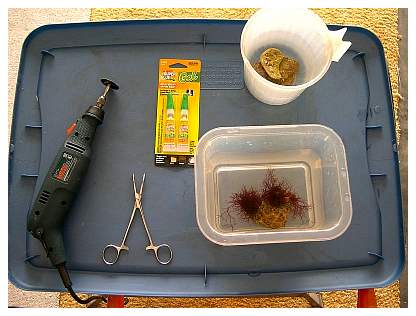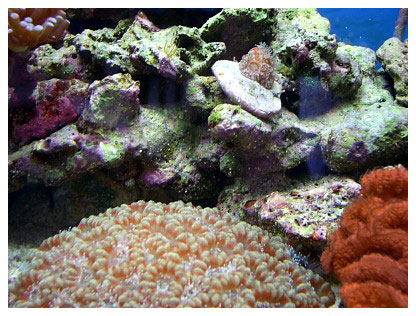|
Propagating Acanthastrea
When I first contemplated propagating my Acanthastrea I looked at the baseball-sized chunk of live rock covered with polyps and asked myself, "How am I ever going to frag that thing without killing it?" My first step was to research how others had managed to propagate Acanthastrea. I quickly discovered the preferred method was to use a tile saw with a water reservoir to keep the blade cool or a bandsaw. With a cost of about $100 for even a cheap power saw, that isn't really an option for the casual hobbyist who may only use the tool two or three times a year. I also found many mentions of hobbyists using a Dremel type tool with various attachments. This appeared to be a viable choice if the point of attachment isn't too large or thick. In my case the coral’s substrate was too thick for a Dremel type tool to thoroughly cut through.
Having come to a dead end, I called my friend Brian Greene at Greene Mariculture and asked him what tools or technique he used. Although he had not previously propagated Acanthastrea, he had just acquired a colony that he planned to fragment and invited me over to watch and help, if necessary. After doing his own research, his tool of choice was a RotoZip™ and a side cutting bit. Brian did manage to remove a few colonies using the RotoZip™, but it wasn't easy or pretty. Trying to secure a large piece of live rock that is completely covered with polyps is difficult without damaging some of the polyps. In addition, it took a long time to cut the rock during which time the coral was out of the water. Finally, using a power tool without being able to secure the work piece is dangerous. I decided that this method wasn't for me, but I did learn a couple of things from the experience. Any future fragments would be mounted to an easily handled and pre-cut substrate in case there was a desire to later fragment the original piece. Although it looked very damaging to the coral, the fragments all looked healthy in Brian’s propagation tank a couple of weeks later. I was at least assured that with reasonable care, the colony wasn't condemned to death by a botched propagation attempt.
Having evaluated the options, it was time to try a new approach. I assembled my equipment (see photo below). The tub was to ensure that fragments wouldn't end up all over the floor. The hammer and chisel were used to do the actual fragmenting, and the razor blade was used to separate any tissue between the fragments. I had pieces of rock rubble and cyanoacrylate glue at the ready for the actual attachment of fragments. After moving the colony to the tub, the tissue contracted and there was a very clear delineation between polyps. Taking a deep breath, I placed the chisel between colonies, gave it a good whack, and separated about a fourth of the colony from the parent colony. I did have to cut a few sections of tissue to free the fragment. The original colony was dipped in saltwater to remove any excess slime and returned to the tank without any apparent problems. I then used the same technique to divide the coral into nearly equal pieces and glued them to the rubble on hand. All the colonies survived and thrived.
 |
As can be seen from these pictures, this coral looks just fine from the front but there's a substantial growth of nuisance algae on the back of the piece of rubble. I tried the usual methods to remove this algae - scrubbing with a toothbrush or picking it off with a tweezers - neither of which worked long-term. Since the algae is currently only on this particular piece of rock, it's time to fragment the coral so as to be able to replace the rock it's mounted to. So really this will be a two-part procedure, removing the coral from the existing rock and dividing it into two colonies to be mounted to new pieces of live rock.
My first course of action was to score and snap off the infested substrate. Using the Dremel to cut the live rock worked fine. Even though it wouldn't cut completely through the rock, the algae infested pieces easily broke off after being notched with the Dremel cutting wheel.
During the process of cleaning up the coral a small fragment was found growing independently of the main colony. If you look closely it can be seen at the very bottom of the picture below surrounded by red algae and red Valonia. Using the Dremel, that colony was easily removed and mounted using super glue gel.
Now it was time to actually fragment the colony. Based on conventional wisdom and advice commonly accepted, I took the Dremel with a diamond cutting wheel (an upgrade from the usual cutting wheels used with this type of tool) and attempted to propagate the Acanthastrea by cutting it apart. True to my prior experience, there was no way that was going to work. The substrate and skeleton were just too thick and dense to be effectively cut with any hand power tool. Any further attempt, I feared, would only harm the coral because of the heat generated by the cutting wheel.
After conceding a power tool was not going to be effective in splitting this colony, I reverted to what I knew would work (a chisel) and fragmented the colony in under five seconds.
|
A month later and the fragments are recovering nicely. |
When researching techniques for propagating Acanthastrea or similar encrusting corals online I couldn't help notice the tendency for some sites to recommend the use of expensive and/or specialty equipment. Various types of saws, power tools or bone cutters were recommended. Even the aquarium reference books I checked tended to recommend sawing or cutting over simply breaking a colony apart. Primary reasons not to break apart a coral are because there is little control over the fragments' size, individual polyps may be severed and there is a greater risk of infection of the severed polyps. These are very real concerns, and I won't dismiss them. However, if you're fragmenting healthy corals, maintain excellent water quality and ensure adequate water flow over the fragments while they're healing, these risks can be minimized. All three of the frags created while writing this article are healthy and growing nicely.
 |
|
The tiny fragment pictured above is the only one I kept, and after two months it's grown from two polyps to four polyps. |
Happy fragging, and be careful out there!
If you have any questions
about this article, please visit my author forum
on Reef Central.
|

